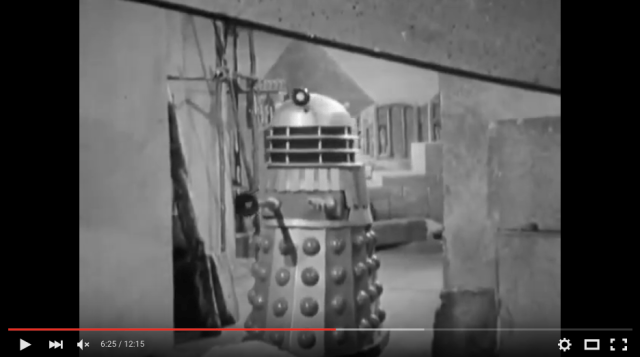
A little while ago, Dr Who writer, information goldmine, and pal, Simon Guerrier, sent an unusual question to mission control at the EES: when did the Daleks’ visit to ancient Egypt in the epic story The Daleks’ Masterplan take place? There is no official line but I thought I could give Simon a view, so I set about watching the one episode in question, and made a few notes. I had suspected the designs would be too bad for it to have been clear what dateable sources they were based on, but in fact they were pretty good. It’s just unfortunate that the sources used range across a couple of millennia of Egyptian history, leaving the Egyptologist shouting ‘the Egyptians never…!’ and ‘anachronism!’ at the TV a few times… Still I managed to give Simon a date and thought the evidence I used to make my case might be of interest.

As the episode opens, the viewer finds themselves inside the stereotypical, richly decorated Egyptian-style interior. The painted walls are inspired by the Tomb of Nefertari (b. 1291 d. 1256 BC, so says Wikipedia), reign of Ramesses II, early 19th Dynasty, as in this photo of the real thing:
 Image from here.
Image from here.
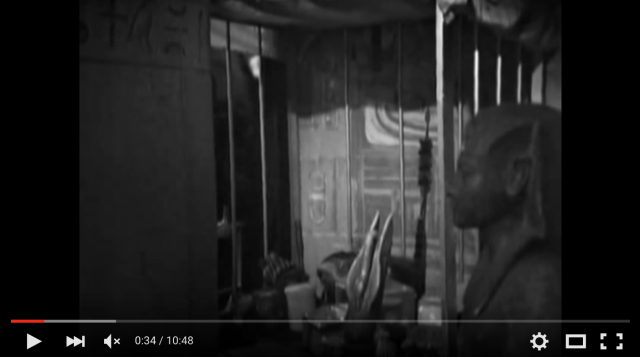
The room is cluttered with treasures, as in the tomb of Tutankhamun (reigned 1332-1323 BC, late 18th Dynasty) when it was first discovered. The pair of ears(?) in this shot recalls the glorious reclining Anubis buried with the boy king.

Image (copyright, The Griffith Institute, Oxford and gloriously reconstructed in colour by Dynamichrome) taken from here.
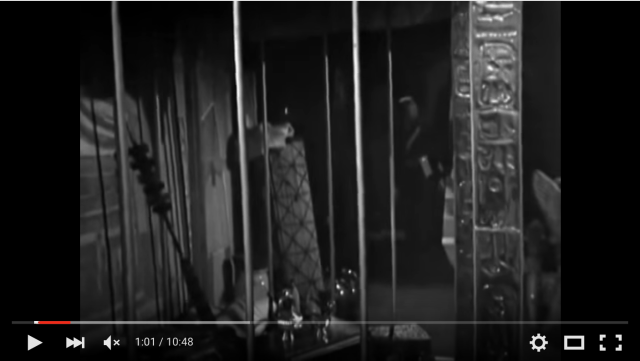
The inscription on the pillar here appears to have been neatly done but is difficult to read. Its appearance is that of beaten gold, echoing more of Tutankhamun’s treasures especially the massive golden shrines perhaps. I can’t think of any evidence of pillars this thin having been encased in beaten gold however…

Image from here.

The supposed mummy here is in fact the story’s bad guy, the Meddling Monk. The humour in our heroes’ realisation that they are not about to be menaced by the living dead after all, is intentional, but the flimsy metallic appearance of the coffin presumably isn’t. The design on the outside isn’t bad, however, and recalls coffins characteristic of the Middle Kingdom (2000-1700 BC), such as this one now in the Metropolitan Museum of Art, New York.
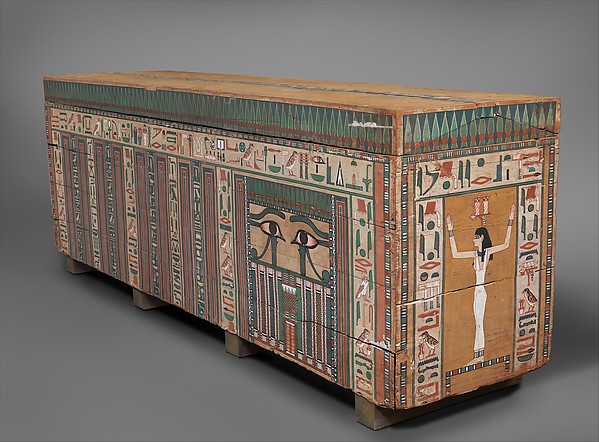
Image from here.

I got quite excited at this point because of the very visible horizontal cartouche in the background. The signs seem good which is unusual for a TV / film set but I can’t quite make sense of them. I think they are a slightly fudged version of Nefertari’s cartouche, and therefore in keeping with the decoration visible elsewhere here. The beginning of the vertical cartouche with the yellow (presumably) background visible beneath, confirms it.
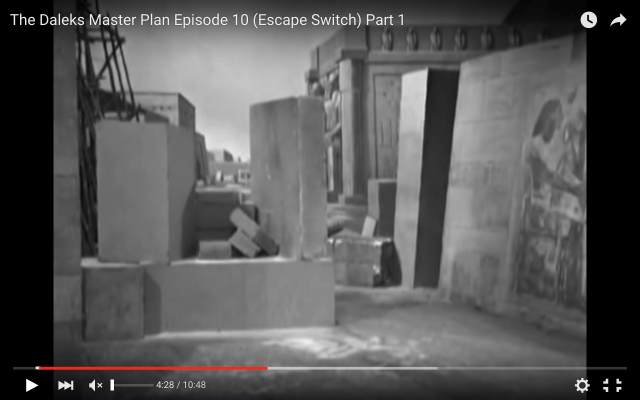
Slightly later in the episode we find ourselves outdoors, apparently amongst a group of monumental stone buildings. The relief on the wall to the right (although it ought to be on the inside of the building not the outside) is reminiscent of the classic Old Kingdom (2686-2181 BC) scene of the deceased seated, typically, before a table piled high with offerings, like this one from the tomb of Niankhkhnum and Khnumhotep at Saqqara:

Image from here.
The row of cobras along the top of the building in the background recalls the south tomb in the Step Pyramid enclosure (3rd Dyn, 2650 – 2575 BC):

Photo my own (at last!).

The style of the wigs here recalls an Old Kingdom (2686-2613 BC) type, as depicted in this famous statue from Saqqara:
 Image from here.
Image from here.
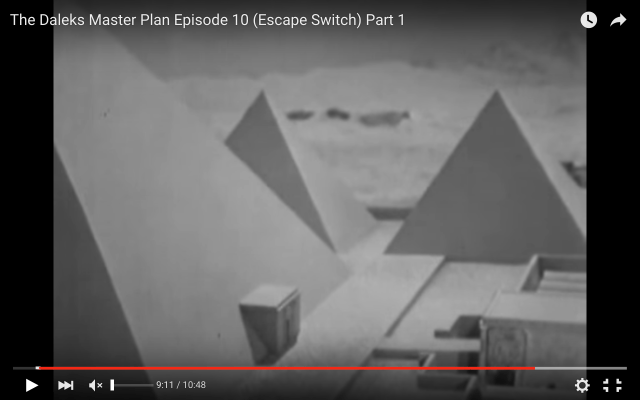
An aerial shot seems to confirm that we are at a pyramid site. One very large pyramid with two smaller ones visible suggests this is probably intended to be Giza but the entrance is ‘wrong’, being of a kind only found later in much smaller tombs e.g. at Deir El Medina (19th and 20th Dynasties, 1292-1077 BC), like this one:

Image from here.

This relief seems well done and has the feel of the Late Period (Dynasties 26 to 30, 672-332 BC) – but I’m struggling to find a clear parallel (can anyone help?). This kind of scene would normally, I think, be found on smaller scale, inscribed on e.g. a naos or other kind of shrine. The inscriptions, though generally well done, do not obviously give anything away.
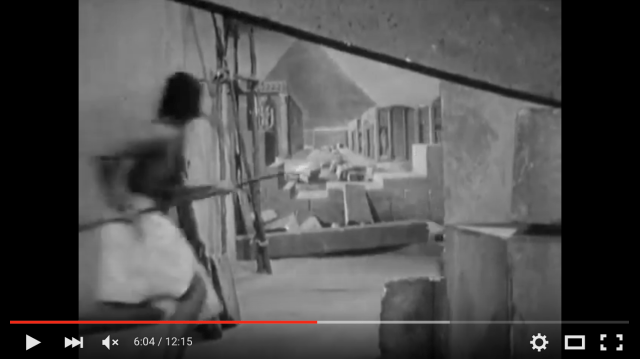
The buildings below and to the right of the pyramid in this shot strongly recall the reconstructed chapel buildings in the Step Pyramid enclosure (3rd Dynasty, 2686–2613 BC):

Photo my own.
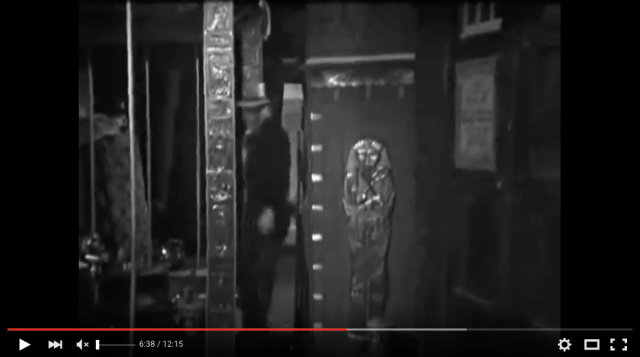
Towards the end of the episode we return to the location of the opening scenes. As the Doctor approaches the TARDIS (at right) he passes a wooden cabinet(?) with a metallic image of pharaoh, presumably intended to look like gold. Although it looks like no genuine artefact I know of, the iconography is obviously that of Tutankhamun, as this coffinette of his shows:
 Image from here.
Image from here.
One final bit of something to go on occurs in dialogue, at approx. 10.00: “…the same mortals that build war machines that throw fire. When Hyksos returns, you’ll see the end of your.. gods.” The Hyksos were a race of foreigners who settled in Egypt during the Second Intermediate Period (1650-1550 BC) and came to rule at least the Delta and northern Nile Valley if not the entire country. They introduced horses and chariotry and other military tech which may be where the ref to ‘war machines’ comes from. ‘Hyksos’ in the story seems to refer to one individual however; the words ‘hyksos’ derives from the ancient Egyptian ‘heka khasut’ meaning ‘ruler of foreign lands’ and it may just be that this was the name given to this particular individual by the Egyptians in the story, but in that case there may be no connection with the Second Intermediate Period group. In any case the reference should probably be disregarded as a dating criterion.
So, in conclusion…
There’s quite a clash of sources from different periods. The opening scenes appear to take place inside a New Kingdom tomb, but also feature a Middle Kingdom coffin (it could have been re-used…). The exterior shots show the episode to have taken place at a pyramid site, the pyramids probably being of the Old Kingdom; these scenes exhibit mostly influences from that period – 3rd through 6th Dynasties (2686-2181 BC) – as you’d expect for a pyramid site, but also one or two things that seem much later. Such sites were in use until much later periods so it could be that the episode takes place at a site dominated by Old Kingdom architecture but in a much later phase of its history. Having said that, the Old Kingdom stuff all seems in pretty good nick, so I prefer to think of it as having been set at that time, as most of the evidence suggests, and just to accept that the other stuff is anachronistic and the mistake of the BBC set designers… Sooo, I gave Simon a date of 2,300 BC – late enough in the period for considerable numbers of smaller, non-royal mastaba tombs to have sprung up around the pyramids, but not at the very end of the period when such sites were falling out of use. Does that seem fair? Do let me know what you think 🙂
By the way, Simon was asking as part of some research for a forthcoming book which I’m really looking forward to seeing: Whographica by Simon Guerrier, Steve O’Brien and Ben Morris will be published in September (2016) by BBC Books.
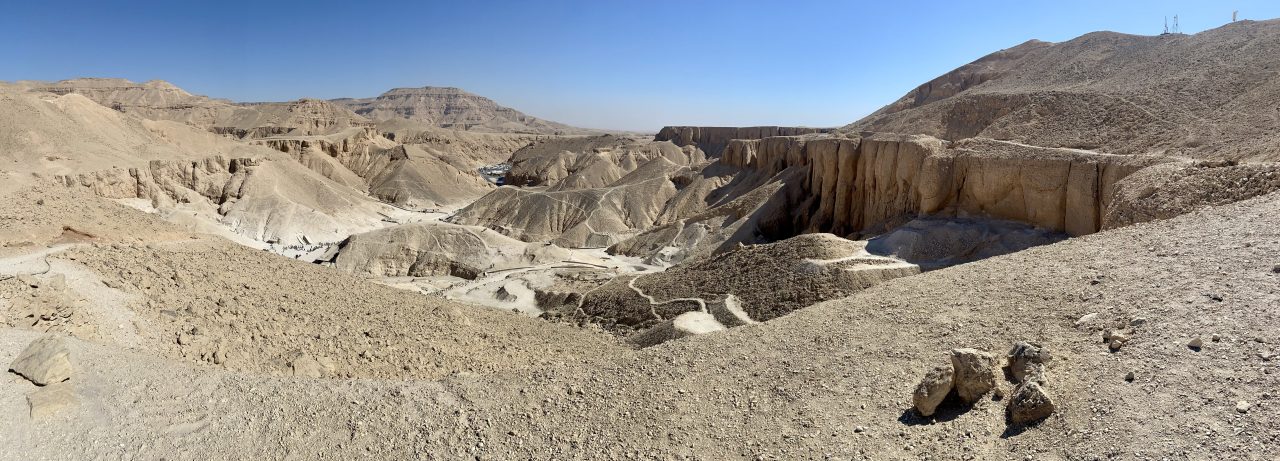


I hope you get an acknowledgement … in a book about Dr Who ! How cool is that !!
No need for me to say this now (thanks Simon!) but *SWELLS WITH PRIDE* yes, I did a credit in The Scientific Secrets… And I seem to remember posting a tweet at the time saying that I was now *in* Dr Who in some small sense… 🙂
Don’t worry – Chris will get a credit. (He’s already got a credit in The Scientific Secrets of Doctor Who.)
Interesting post.
If you’re looking forward to Whographica (as am I), you might be interest in my 2013 book of Who data visualisations, Time & Space Visualiser: http://www.amazon.co.uk/gp/product/0957606206/
I really need to watch my “Lost in Time” Doctor Who DVD’s. 😉 Interesting analysis. Perhaps you can do “Pyramids of Mars” next???
Dave R.
The relief which you describe as having “the feel of the Late Period” is in fact a rather faithful copy of a lintel of Senwosret III from Medamud, with scenes from his sed jubilee, now in the Cairo Museum (JE 56497). Even the restoration at the back of the king’s crown has been copied.
Ah great, many thanks! I wonder how the designers came across this…
You’re welcome, Chris. I don’t know much about Doctor Who, but I understand this episode dates from 1966? Interestingly, in that same year the Egyptian-style Rosicrucian Egyptian Museum in San Jose was completed – and guess what? Part of the same relief was used for the decoration of the delivery gate of that building. Coincidence? Or had this relief somehow come to the attention of a wider public in the previous years?
Yes, it was 1966 or thereabouts. The connection with the Rosicrucian is v interesting! I wonder what happened to bring the relief to people’s attention…I’ll keep thinking! Thanks again 🙂